Strengthening social justice to address intersecting inequalities post-2015

The people most likely to be left behind by development are those facing
‘intersecting inequalities’, or economic deficits intersecting with discrimination and
exclusion on the grounds of identity and locational disadvantage.
• The experience of seven countries (Brazil, Ecuador, Bolivia, India, Ethiopia,
Pakistan and Nepal) shows that key ingredients for addressing intersecting
inequalities are: social movements demanding changes in the ‘rules of the game’;
political trajectories and processes of constitutional change that facilitate and
actualize these changes; social guarantees, opportunity enhancements and
developmental affirmative actions as well as specific policies and programmes
which show commitment to reduce intersecting inequalities over time.
• The post-2015 agenda can help establish global norms which will support and
encourage mobilisation to tackle intersecting inequalities, including a strong
commitment to universal quality basic services, and the development of countryspecific
frameworks of targets and indicators monitoring intersecting inequalities.
[gview file=”http://nailakabeer.net/wp-content/uploads/2016/01/Strengthening-social-justice-to-address-intersecting-inequalities-post-2015.pdf”]
